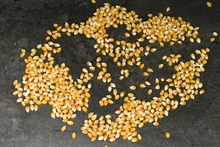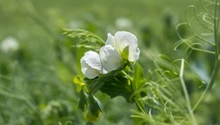
Five years ago, Gnana Saravanan quit his six-figure paying job at an MNC to return to his village in Pollachi to work on his father’s 36-acre farmland as a farmer. As far removed from the allure and comfort of city life their life was going to be in Pollachi, his wife followed him leaving her assignment with a multinational company.
“I belong to the generation that is the last link between the older generation of agriculture-practicing farmers and the more disconnected-from-their-roots future generation,” shares Saravanan, who is today a recipient of the Yuva Krishika Award from Govt. of Kerala. “If I quit farming it will be a great disservice that I will be doing to my son and his generation, they will never know what earth smells like.”
Returning to the Roots
Gnana Saravanan grew up around his father’s farm amongst the lush green coconut groves and played amongst the cattle and vast open fields. But his farmer father wanted him to get an education and get away from the vagaries of farming-irregular income, hard physical labor, and lack of social acceptance.
After completing his education, he picked up a job with a multi-national company and settled down. But a few years into the rut of a 9-to-5 routine, Saravanan felt restless as if he belonged somewhere else. He was doing the job just to please his parents but his heart lie in the fields of Pollachi. After 8 years he decided to quit. His father was not happy.

Beginning New Chapter of Life
When he got into farming, he decided on two things- one was he would steer clear of using any chemical on the field, and do farming the natural way and the second was to make sure it generates regular income for him, so that in the near future he can prove it is as a viable career option as any other.
So, what makes his farm different? How has he been able to manage and maintain a steady flow of income? Did he make the right decision by quitting the safety of his job and returning to agriculture?
He started with an integrated farming model that uses a combination of short-term and long-term yielding crops, incorporated with systems and techniques that make a farm self-sufficient. In addition to farming, he also believes in the idea of creating more agri-prenuers. This 360-degree approach to farming growing, packaging, and marketing is very effective in making agriculture a viable livelihood option.
Unlearning Natural Farming
Saravanan thought he knew everything there was to know about natural farming. That was until he attended a three-day workshop on natural farming by The Art of Living.
The techniques and topics that were discussed in the training were a revelation on everything that should not be done in the name of natural farming, how to enrich the soil using simple cow dung and cow urine; best ways of optimizing his land so that it gives best output in the limited or same area of land; making bio-fertilizers at home at nearly zero cost; and using bio principles to soften soil and replenish its natural nutrients.
Armed with the new holistic training in natural farming in its true essence, Saravanan set about implementing what he learned. He set up a jeevamrut preparing unit on his farm that uses dung from the cow and additions to enhance the microbial activity of the soil, which when used on the fields enriches the nutrient content of the soil. He noticed a marked improvement in the health of the plants. The yield was also better than before.
“Earlier I used to prepare slurry of cow dung and just throw it on the farm but the training taught me how to enrich the manure and now I can see the difference that it has made,” adds Saravanan. The produce that he receives from natural farming has higher nutritional value as compared to chemically grown ones. He explains, for example, that coconuts contain a very beneficial acid- lauric acid, which is almost 50% in naturally grown ones as compared to 30% in chemically treated ones. Even for storing the dry coconut, he ensures that they are sun-dried, like he learned at the workshop.
Saravanan feels there are two problems ailing farmers today- lack of guidance and handholding that leads to farmers making mistakes that can be easily avoided with some guidance; and the negative belief that agriculture can never make profits for them. In this scenario, “I feel what Art of Living is doing is a huge service to the farming community.”

Agri-Entrepreneur: Farmers, Middlemen and the Way Out
As times change globally, where the world is shrinking into a marketplace, it is important to enable farmers to innovate with the right upgraded marketing tools to take their products to a wider market at profit margins they set for themselves, instead of being dictated by middlemen. The most painful part of agriculture is depending on middlemen to sell their harvest. Most of the small farmers are victims of unscrupulous middlemen who invariably never give them a fair price.
In the absence of a direct link with the consumers, the farmers are at the mercy of the middlemen who occupy the entire space between the production and the ultimate sale of the produce, making them powerful beyond their means, where farmers often find themselves in a disadvantageous position.
This is where Art of Living intervenes to help create a platform for farmers where they can come together and benefit from working collectively. The aim of Sri Sri Institute of Agricultural Science and Technology under The Art of Living is to make small farmers self-sufficient and more importantly debt-free. They conduct periodic training on natural farming throughout the country and teach the marginal farmers about the right way of farming, the correct method of applying natural fertilizers, and pest control without resorting to chemicals and enhance their revenue by creating value-added farm-based products. So far over 22 lakh farmers have been trained in Natural farming by The Art of Living.
Saravanan has diversified his agricultural activity into dairy, composting, and creating value-added products like cold-pressed coconut oil and Ghee from desi cows. This generates a steady income for him. His wife Krishnasudha runs the dairy unit of his farm, tending to the 20 cows that they have and overseeing the preparation of ghee, packaging, and selling it directly to the consumer.
His farm is now a model farm, visited by other farmers as a center of learning best practices. The government of Kerala has recognized his work by awarding him the Yuva Krisika Award. More than 15000 people including farmers and delegations have visited his farm till date
Saravanan is content and happy farmer now, doing what he loves. His aged father sums up the feeling, “I have everything I want with my son and grandkid staying together. What else do I need for a blissful life?”
Saravanan's Deesan Farm
Saravanan’s farm has a heterogeneous mix of coconut groves, livestock, a vegetable farm, a vermicompost unit, a biogas plant, and a processing unit to manufacture value-added products – cold pressed coconut oil and cow ghee from the traditional process
He ensures that nothing on the farm goes to waste. The cow dung is used to create Jeevamrut – a natural supplement for the plants, biogas is also generated with leftover dung, and any excess is used in the vermicomposting unit. From his 2-acre vegetable patch, he produces chilies, tomatoes, brinjal, and pumpkin that is directly sold at retail in the city.
A dairy unit consisting of 20 indigenous cows breed produces 12 to 14 liters of milk per day. On average, he sells 100 ltrs of cow’s milk to the cooperative. The Vermicompost unit also produces 10 tons of compost every 45 days. It helps him to add micronutrients to the soils and he also sells compost for R.10 per kg.
The fish pond at the end of the northern slope of his land acts as a natural reservoir storing the rainwater that would otherwise have run off his land. Saravanan has received 3 state government awards until now for creating a roadmap in farming for coming generations













